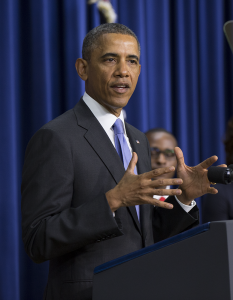
Georgetown fares well in the updated Department of Education College Scorecard, presented by President Barack Obama.
President Barack Obama presented an updated College Scorecard, a system that informs prospective students about college affordability and graduate workforce participation, with Georgetown displaying above-average rates in these major categories, during his weekly address to the country Sept. 12.
The updated scorecards, revealed on the Department of Education’s website, include information about the earnings, debt and loan payments of each school’s graduates. The first scorecard system was announced in President Obama’s 2013 State of the Union address.
The College Scorecard website presents a general overview of each university’s statistics, ranging from SAT scores to retention rates. Data from more than 7,000 colleges was analyzed for the new database.
The three most prominent statistics are average annual cost, graduation rate and salary 10 years after attendance, measured among students who receive federal aid for tuition. For Georgetown, these numbers are $27,801, 93 percent and $83,300, respectively, which represent above-average rates in all three categories.
Georgetown Director of Media Relations Rachel Pugh praised the scorecard’s transparency, in regard to Georgetown information, that could aid applicants in making their decision about which college to attend.
“The scorecard is a reflection of two critical areas related to higher education that Georgetown is constantly working on: access and affordability,” Pugh wrote. “Georgetown is among the top of a list of highly selective and competitive schools [in this regard].”
In his address, Obama said that his administration was compelled to provide more data about colleges to potential applicants, which will increase transparency in the college ratings system.
“Everyone should be able to find clear, reliable, open data on college affordability and value,” Obama said. “Many existing college rankings award schools for spending more money and rejecting more students. … That doesn’t make sense. It has to change.”
Obama argued that access to information about education matters in today’s global society. He said that the United States needs an educated workforce to compete with other countries and that scorecards can help further that goal.
“The country with the best educated workforce in the world is going to win the 21st-century economy,” Obama said. “I want that to be America.”
Originally, the system was intended to rank each university, providing definitive federal rankings based on college affordability information.
However, the originally planned rankings system was changed to a more streamlined format that now simply presents data for viewers, allowing them to compare universities themselves.
“We had a number of concerns about the [original] ratings system because you can’t capture everything in statistics,” Georgetown’s Vice President for Federal Relations Scott Fleming said. “That was a debate that went on for several years.”
Fleming said the president’s administration and the Department of Education had worked closely with Georgetown as well as other schools on the original design, which led them to change their minds about rating schools and instead simply offer statistics.
“We submitted comments to the Department [of Education] as they were working on the ratings system,” Fleming said. “I think there’s little doubt that all of the input that went into the ratings system had an impact on shaping the scorecard.”
Dean of Undergraduate Admissions Charles Deacon said the data does not represent the entire Georgetown student body. Only those who utilize federal aid such as Pell Grants to attend Georgetown are accounted for in the statistics. Students who do not receive these benefits are not included in the different categories outlined in the scorecard.
“From the point of view of how do our graduates do, at least financially, it’s good,” Deacon said. “[Just] understand that the particular number is calculated from data that probably represents the lower half of our student body socioeconomically.”
According to Deacon, the data can help aspiring college students who want to avoid debt.
“The benefit for the middle-lower income student coming to Georgetown is [that it’s] likely to pay off on a better salary or better job prospects,” Deacon said. “If that’s what they want.”
Pugh added that university officials, in conjunction with the Department of Education, can customize the scorecard.
“[W]e were not asked to comment on the final configuration released this past weekend,” Pugh wrote in an email to The Hoya. “It is encouraging that the Department of Education intends to allow institutions to work to customize their profiles, though the details of that process have not been laid out.”
Fleming said that a scorecard is preferable to a ranking system, but neither can completely capture what happens to each student at Georgetown on a personal level. He said he is unsure that the scorecard’s main features, such as median income years after graduation, tell the whole story about Georgetown graduates.
“Georgetown is proud of the fact that we are educating men and women for others, which means a good number of Georgetown alumni and graduates go on to the Peace Corps, Teach for America, [the] Jesuit Volunteer Service, things of that sort,” Fleming said. “That can’t be reflected in a simple dollars and cents chart.”
Deacon said that Georgetown would use the data for its own fundraising purposes.
“I think that what we will probably do … is use that [data] with our alumni and say things that we’re doing to support the lower income students, that we do have payoff with good results,” Deacon said.
“Therefore, the more you can give us [in money and] scholarships, the better the results.”




















